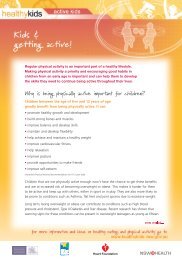I Move We Move - Good For Kids - NSW Government
I Move We Move - Good For Kids - NSW Government
I Move We Move - Good For Kids - NSW Government
You also want an ePaper? Increase the reach of your titles
YUMPU automatically turns print PDFs into web optimized ePapers that Google loves.
Active play in group time<br />
Group time is a very important component of a child’s day. It can be useful to help develop<br />
fundamental movement skills, as well as facilitate communication, team work and problem solving<br />
skills. Group times are great opportunities to encourage older toddlers and preschoolers to be<br />
physically active as there are a wide range of activities and games that staff can facilitate in small<br />
or large groups.<br />
Here are some ideas to engage children in physical activity during group time:<br />
• Musical chairs, limbo, “Simon Says”, elastics and, “What’s the time Mr Wolf?”<br />
• Play charades – construct movement charade cards with the children<br />
• Mirror games – children mirror the movement made by the adult, or the movement of<br />
another child (done in pairs)<br />
• Play games such as ‘I can see’, ‘What can you see?’ e.g. ‘I can see a plane flying high and low’,<br />
. . . ‘a tree swaying in the breeze’ . . . ‘a little boat on big waves’. The children perform what the<br />
adult calls out. The children can also take turns calling out ‘I can see’<br />
See The Physical Activity Handbook – Preschoolers (Table 5, page P.10) for more ideas.<br />
Active play verbal prompts<br />
This includes giving encouragement for children's physical activity efforts during free active play, for<br />
example 'Great try, have another go". Also use prompts to challenge, extend activity and improve<br />
skills e.g. "Show me how fast you can run", or "What other things can you leap over?" You can<br />
also encourage movement through imitation of your movements by saying "See if you can balance/<br />
hop/jump like me." All of these types of verbal prompts are useful for encouraging physical activity<br />
during active play 23 .<br />
<strong>For</strong> more ideas on verbal prompts to support children being physically active see<br />
pages 5.5–7 of Section Five, Learning How To <strong>Move</strong>.<br />
Be an active role model<br />
To be physically active children need support and guidance from adults. Parents, carers and early<br />
childhood professionals play an important role in forming healthy habits in children. Children learn<br />
through role modelling. To be physically active, they need you to be.<br />
It is important for staff to be active role models by participating in physical experiences such as<br />
games, dancing, action songs and outdoor play. Adult participation in any physical activity increases<br />
the participation rates of children, especially if staff demonstrate that they enjoy and value being<br />
active. This also maximises children's potential learning opportunities.<br />
I <strong>Move</strong> <strong>We</strong> <strong>Move</strong>, The Guide Edition 1 August 2009<br />
AREA HEALTH SERVICE<br />
4.4




